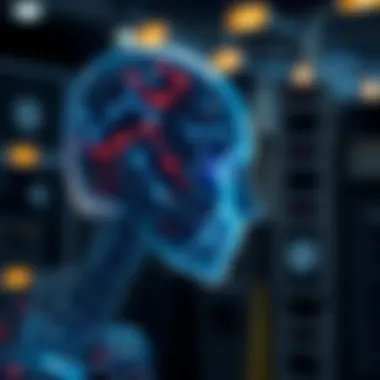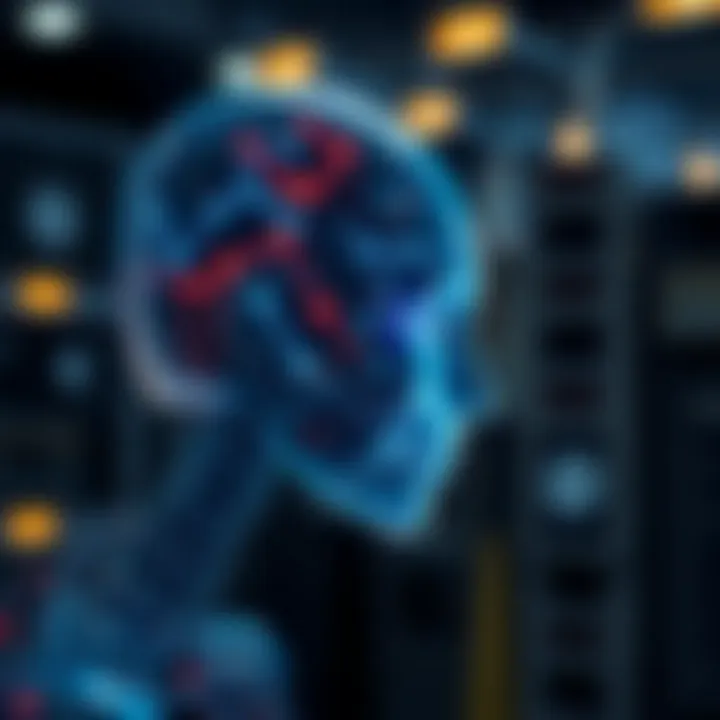In-Depth Insights into Neural Network Machine Learning


Intro
In the ever-evolving landscape of technology, one particular area garners significant attention—neural network machine learning. Whether you are thinking about how to utilize data more intelligently or if you are simply intrigued by the capability of machines to learn from experiences, understanding neural networks offers a glimpse into the future of artificial intelligence.
These intricate systems, inspired by the human brain, represent a paradigm shift in how machines can be designed to process information. From healthcare to finance, their applications are vast and transformative. The goal of this guide is to demystify these concepts, break down complex theories, and touch on their practical uses, particularly in investment and data-driven decision-making.
The significance of this technology can’t be overstated. As these networks grow more sophisticated, they help in predicting market trends, improving customer experiences, and fine-tuning operations across various sectors. Engaging in neural networks is not merely about the technicalities involved; it is about understanding how they can be leveraged for tangible outcomes.
In what follows, we will examine key terminology and concepts that form the foundation of this discipline, explore the different architectures of neural networks, and discuss how these applications translate into real-world scenarios, especially in technology-driven investment strategies.
Intro to Neural Networks
The realm of machine learning has witnessed remarkable advancements in recent years, with neural networks standing out as a pivotal component of this evolution. Understanding neural networks is not solely an academic exercise; it's a lens through which we can perceive and harness the power of artificial intelligence in a multitude of applications. This section underscores the significance of grasping the principles and frameworks of neural networks, highlighting how they transform raw data into meaningful insights.
Definition and Significance
Neural networks can be broadly defined as algorithms modeled on the human brain's structure, designed to recognize patterns and solve complex problems. They consist of interconnected layers of nodes—akin to neurons—that processing information. Each node receives inputs, applies specific weights, and utilizes an activation function to produce an output. This layered approach enables neural networks to perform intricate tasks such as image recognition, language processing, and even predictive analytics.
The significance of neural networks extends far beyond their technical operations. They form the backbone of many modern applications, such as:
- Image Recognition: In social media platforms, neural networks can automatically tag individuals in photos.
- Natural Language Processing: Companies like Google and Microsoft utilize neural networks in tools to translate languages or generate text.
- Medical Diagnostics: Neural networks assist doctors in detecting diseases through imaging techniques, making diagnosis faster and more accurate.
In essence, understanding neural networks is crucial for investors, financial advisors, and analysts as it illuminates the technology driving significant innovations in various domains. It allows professionals to recognize potential market shifts driven by advancements in AI and machine learning.
Historical Background
To appreciate the contemporary application of neural networks, it is important to explore their historical context. The journey began in the late 1940s with the work of Warren McCulloch and Walter Pitts, who developed a mathematical model of a neuron. This initial model laid the groundwork for what would eventually become artificial neural networks.
Throughout the 1980s, there was an evolution in these models, primarily due to the introduction of backpropagation by Geoffrey Hinton and others. Backpropagation provided a systematic way for updating weights in a neural network, leading to more effective training processes. The 1990s saw further advances, as computational power increased, allowing for more complex networks to be constructed and trained.
However, it was not until the dawn of deep learning in the 2010s that neural networks gained widespread recognition. The introduction of deep architectures, which consist of many hidden layers, allowed these networks to learn representations from data more effectively. Now, these technologies are at the forefront of artificial intelligence, influencing everything from economics to social media behaviors.
Fundamental Concepts
Understanding the fundamental concepts of neural networks is like finding the key to a treasure chest filled with data-driven insights. These principles not only form the backbone of how neural networks operate but also highlight the strong potential for innovation across various industries. In this section, we will delve into the essential components that influence everything from processing data to training models effectively.
Neurons and Activation Functions
Neurons in a neural network mimic the biological neurons found in our brains, serving as the fundamental building blocks of machine learning algorithms. Each neuron receives input, processes it, and produces output that is passed on to subsequent layers. However, they require something called activation functions to determine output based on input. These functions inject non-linearity into the model, allowing it to learn complex patterns rather than just linear relationships.
Sigmoid
The Sigmoid function is one of the first activation functions most people encounter when exploring neural networks. Its signature S-shaped curve outputs values in the range of 0 to 1. This feature makes it particularly effective for binary classification tasks. A key characteristic of Sigmoid is that it smooths the output, helping the model converge to a solution.
However, this smoothness comes at a price. The derivatives can lead to what is known as the vanishing gradient problem, slowing down the learning process significantly when gradients get too small. This makes it less favorable for deeper networks.
Tanh
Next up, we have the Tanh function, which appears to be a more robust version of Sigmoid. Unlike Sigmoid, Tanh outputs values between -1 and 1, which means it centers the data, making learning faster. Its steep gradient helps mitigate the vanishing gradient problem to some extent. However, it still suffers from saturation for high and low values, leading to slow learning under certain conditions. Thus, while Tanh can be an improvement over Sigmoid, it's not without its downsides.
ReLU
When it comes to modern neural networks, the Rectified Linear Unit (ReLU) often steals the spotlight. Its key feature is that it outputs zero for negative inputs and the raw input itself for positive inputs. This simplicity allows it to address the vanishing gradient problem effectively, making it a very popular choice in deep learning. Its unbounded positive output range accelerates convergence, leading to faster training times.
Yet, ReLU isn't flawless. If the neurons get 'stuck' during training, sometimes referred to as dying ReLU, they can stop learning entirely. This is an important consideration when building and training models, but overall, its advantages in speed and simplicity often outweigh these risks.
Layers in Neural Networks
Layers are critical to the structure of neural networks. Each layer plays a specific role in processing data, contributing to the network's ability to learn and perform tasks effectively. The basic architecture includes three types of layers: Input Layer, Hidden Layers, and Output Layer.
Input Layer
The Input Layer is where it all begins. This layer receives the raw data and converts it into a format suitable for processing by the subsequent layers. The crucial characteristic of the input layer is its direct correlation with the features of the dataset; each neuron corresponds to one feature of the input data.
While the input layer does not perform any computation, it is essential for setting the stage for learning, as the quality of data directly impacts the quality of insights extracted.
Hidden Layers
Hidden Layers are where the real action happens. They transform inputs into outputs through weighted connections and activation functions. The more hidden layers in a network, the deeper the network, hence the term Deep Learning. The key trait of these layers is their ability to learn complex features and represent the data at multiple levels of abstraction. This flexibility allows networks to tackle diverse problems, from vision tasks to language processing. However, having too many hidden layers can lead to overfitting, causing the model to perform poorly on unseen data.
Output Layer
Finally, we arrive at the Output Layer, where predictions are made. The output layer summarizes the information processed through the network, translating complex feature representations into actionable insights. It often uses activation functions tailored to the specific task, like softmax for multi-class classification. One key aspect of the output layer is that it directly affects the interpretability of model predictions. If misconfigured, it can lead to misleading results, which is why meticulous attention is vital when designing this layer.
Training Neural Networks
Training is the heart and soul of any machine learning model, and neural networks are no different. The process involves feeding data through the network and adjusting weights based on the errors in prediction. Key components of training are Forward Propagation, Backpropagation, and Gradient Descent.
Forward Propagation
Forward Propagation is the first step in training a neural network. During this phase, input data is fed into the network, and calculations are performed layer by layer until the final output is produced. One key aspect of this process is that it helps to identify how well the model performs against its expected output. However, the real learning happens after the forward pass, when the results are compared against the actual data. This stage is crucial because it sets the groundwork for adjusting the model.
Backpropagation
Following forward propagation, we have Backpropagation. This is where the magic of learning takes place. During backpropagation, the model calculates the error and distributes this error backward through the network to update the weights. The key feature of backpropagation is the efficient use of the chain rule of calculus to compute gradients. It efficiently adjusts weights, minimizing error and progressively refining the model's performance. However, it requires careful tuning, as improper adjustments can lead to poor learning outcomes.
Gradient Descent


Lastly, Gradient Descent is a vital optimization technique used to minimize the error of the model. This algorithm iteratively adjusts weights based on the calculated gradients to find the optimal values. Its key characteristic lies in how it helps navigate the multi-dimensional space of possible weights. Nonetheless, choosing the right learning rate is crucial, as a rate too high can overshoot the optimal point, while too low can slow down the learning process.
As we delve deeper into these fundamental concepts, it becomes evident how each plays a vital role in the overall efficacy of neural networks. Understanding these elements will empower practitioners not just to implement models, but to innovate and push boundaries in various applications.
Types of Neural Networks
Understanding the different types of neural networks is crucial for anyone looking to harness their potential in various applications. Each type serves a unique purpose and is optimized for specific tasks, which makes them key players in the landscape of machine learning and artificial intelligence. Different architectures yield distinct advantages and limitations when applied to various problems. Knowing these differences helps in choosing the right tool for the job.
Feedforward Neural Networks
Feedforward Neural Networks, often considered the simplest form of artificial neural networks, showcase how data moves in one direction—from input to output. This straightforward architecture enables the network to learn representations through a series of layers, where each layer applies transformations to the input data.
Characteristics:
- Structure: Comprises an input layer, one or more hidden layers, and an output layer.
- Activation Functions: Commonly uses functions like ReLU or sigmoid to introduce non-linearity.
Benefits:
- Effective for straightforward tasks like regression and classification.
- Its simplicity allows for ease of understanding and implementation.
However, one should note the limitations of Feedforward Neural Networks. They struggle with sequential data and have limited capacity to capture temporal dependencies, often leading to subpar performance in tasks requiring memory, such as language modeling or time-series forecasting.
Convolutional Neural Networks
Convolutional Neural Networks (CNNs) have revolutionized how machines interpret visual data. By systematically taking smaller regions of an image and applying transformations, CNNs excel at identifying patterns. Their ability to recognize shapes, textures, and colors, while reducing the number of parameters needed, makes them indispensable in computer vision.
Characteristics:
- Convolution Layers: Extract features from the input image by applying filters.
- Pooling Layers: Reduce dimensionality while retaining important features.
Benefits:
- Highly effective at image and video analysis tasks—think facial recognition and even self-driving car technologies.
- They are robust against shifts and distortions in inputs, improving accuracy in real-world applications.
Nonetheless, CNNs require extensive datasets for training, which may not always be available, posing a challenge for small startups or niche applications.
Recurrent Neural Networks
Recurrent Neural Networks (RNNs) are tailored for sequential data, where previous data points influence the current output. Imagine reading a novel; the context from earlier chapters shapes the meaning in later sections. RNNs operate similarly, maintaining a hidden state that captures this context over time.
Characteristics:
- Feedback Connections: Allow output from previous steps to influence future predictions.
- Long Short-Term Memory (LSTM) Units: Special adaptations to counteract issues like vanishing gradients, making them suitable for long inputs.
Benefits:
- Ideal for natural language processing tasks, such as translation or sentiment analysis.
- Able to learn patterns over time, making them useful in music generation or stock price predictions.
However, RNNs can have high computational costs, and training them effectively can be cumbersome due to problems like exploding gradients.
Generative Adversarial Networks
Generative Adversarial Networks (GANs) present a fascinating paradigm in machine learning, where two networks compete against each other. Think of them as a contest between an artist trying to create a masterpiece and a critic attempting to identify if it’s real or fake. The artist (the generator) continuously improves based on feedback from the critic (the discriminator).
Characteristics:
- Dual Networks: The generator creates data, while the discriminator evaluates it.
- Adversarial Training: The interaction helps both improve steadily, raising the quality of generated data.
Benefits:
- Excels in generating photorealistic images, music, and texts, expanding creative horizons in media.
- Has potential applications in simulating environments for training other models, which can be particularly useful in robotics.
The primary challenge with GANs lies in their intricate training process that may lead to instability or mode collapse, where the generator produces limited varieties of outputs.
Each type of neural network has unique architectures and functionalities, impacting the landscape of AI applications. By grasping these distinctions, stakeholders can make informed choices tailored to their specific needs.
In summation, the vast array of neural network types provides ample opportunity for innovative solutions across industries. Understanding their structures, advantages, and challenges is the first step toward effectively utilizing these powerful tools in real-world applications.
For deeper insight into neural network applications, you might check out resources on Wikipedia or Britannica for foundational knowledge, as well as engaging communities on platforms like Reddit where enthusiasts share fresh ideas and practices.
Applications of Neural Networks
In the vast landscape of technology, the applications of neural networks have carved out a notable niche, acting as a backbone for numerous innovations. Their significance in various fields cannot be overstated. From automating mundane tasks to enhancing decision-making processes, the versatility of neural networks means they’re a critical tool for anyone looking to harness the power of artificial intelligence. By employing neural networks, industries are able to process vast amounts of data efficiently, leading to both operational savings and a competitive edge.
Natural Language Processing
Natural Language Processing, or NLP, showcases the prowess of neural networks. These systems allow machines to understand, interpret, and generate human language in a way that’s both meaningful and contextually appropriate. Consider how chatbots, powered by recurrent neural networks (RNNs), can engage in conversations. They analyze the sentiment behind user queries, thereby tailoring responses much like a human would.
The applications in this domain are impressive:
- Sentiment Analysis: This analyses customer opinions and feelings toward products or services, assisting businesses to gauge market sentiment and adjust strategies accordingly.
- Language Translation: Tools like Google Translate leverage deep learning models to translate languages with increased accuracy over traditional methods.
- Speech Recognition: Systems such as Siri or Alexa utilize neural networks to comprehend spoken language, converting spoken words into actionable data.
Image and Video Recognition
The realm of image and video recognition stands as a testament to the capabilities of neural networks. Convolutional Neural Networks (CNNs) play a pivotal role here. They dissect images into manageable patterns and features, enabling the classification of photographs, detection of anomalies, and recognition of objects.


Key applications include:
- Facial Recognition: This tech is now embedded in security systems and social media platforms, allowing for seamless user identification and tagging.
- Automated Surveillance: Neural networks help detect unusual activity in real-time, thereby bolstering security measures in sensitive environments.
- Medical Imaging: In healthcare, deep learning assists in analyzing X-rays and MRIs, greatly enhancing diagnostic accuracy.
Medical Diagnosis
In the medical field, neural networks are emerging as potent allies for practitioners. By sifting through clinical data, they can assist in diagnosing diseases early and accurately. The ability of these networks to learn from historical patient data means they can identify patterns that the human eye may overlook.
Crucial functions include:
- Predictive Analysis: Algorithms can predict disease outbreaks or patient health issues, which can potentially save lives.
- Personalized Treatment Plans: By analyzing genetic information and medical history, neural networks can help tailor treatments to individual patients.
- Drug Discovery: Neural networks are also being leveraged to develop new medications, speeding up the process of bringing drugs to market.
Financial Forecasting
The financial world thrives on data, and neural networks are successfully navigating this complex terrain. Their ability to process and analyze massive datasets helps in predicting market trends and investment opportunities. This aspect is particularly important for financial analysts and investors.
Key areas of implementation include:
- Trend Prediction: By analyzing historical data, these models can forecast stock prices, providing insights for traders.
- Risk Management: Neural networks help identify at-risk assets by recognizing patterns that precede financial downturns.
- Algorithmic Trading: High-frequency trading relies heavily on neural networks to execute trades at optimal times.
As neural networks become more sophisticated, their role in these various fields solidifies, illustrating a future where machine learning isn't just a supplementary tool, but a principal driver of innovation.
Challenges in Neural Network Learning
Neural network learning, while promising and deeply impactful, does come with its own set of challenges that need thorough consideration. Understanding these challenges is critical not only for developers but also for stakeholders like investors and financial advisors, as they directly correlate with the reliability and efficacy of predictive models in various domains. Addressing issues such as overfitting, data quality, and computational demands ensures that the implementation of neural networks translates into real-world benefits without running into significant hurdles.
Overfitting and Underfitting
One of the most vexing problems in machine learning is the balance between overfitting and underfitting. Overfitting occurs when a model learns the nuances of the training data too precisely, capturing noise rather than the underlying distribution. This results in excellent performance on training datasets but leads to poor generalization on unseen data. Think of it akin to a student who memorizes answers for an exam without understanding the subject; they may ace the test but struggle when asked to apply knowledge in different scenarios.
Conversely, underfitting happens when a model is too simplistic to capture the underlying trend of the data. It's like trying to fit a square peg into a round hole; the model does not have sufficient complexity to represent the information well. Striking a balance between these two extremes is vital. Common methods to combat these issues include:
- Cross-validation: This technique helps evaluate the model's performance on different subsets of the data.
- Regularization techniques: Methods such as L1 and L2 regularization penalize complex models, helping to prevent overfitting.
- Using more training data: Sometimes, simply increasing the dataset size can enhance model robustness.
Ensuring that a model generalizes well is a continuous cycle of evaluating and adjusting.
Data Quality and Preprocessing
In the world of machine learning, the phrase "garbage in, garbage out" holds particularly true. The effectiveness of neural networks largely hinges on the quality of the data that fuels them. Poor-quality data can lead to skewed outputs and questionable predictions. Therefore, addressing data quality and preprocessing is paramount.
Data needs to be cleaned, normalized, and sometimes transformed before it’s fed into a neural network model. Here's what data practitioners should focus on:
- Missing values: Identifying and properly handling missing data points can help maintain the integrity of the dataset.
- Outliers: Recognizing extreme values that can distort results is crucial. Strategies may include trimming, winsorizing, or using robust measures of central tendency.
- Feature scaling: Techniques like min-max scaling or standardization make sure different features contribute equally to the model's learning process.
A solid data preprocessing strategy can save time later on by preventing the model from encountering errors due to poor inputs and improving the overall accuracy of the predictions.
Computational Demands
Another hurdle in developing neural networks is the computational demands they impose. Training deep learning models requires significant processing power and memory. In many cases, the training process can take hours or even days, depending on the complexity of the model and the size of the dataset. This is where understanding the infrastructure becomes vital.
Investing in high-performance hardware, such as GPUs or TPUs, can drastically reduce training times, but it also incurs additional costs. Additionally, deploying models in a real-time environment introduces further challenges:
- Scalability: As user demand increases, models must scale effectively without compromising performance.
- Energy consumption: The need for robust computation comes with a high energy footprint, prompting considerations for sustainability in model training and deployment.
- Latency: In fields like financial trading, the speed at which a model provides predictions can be critical; thus, minimizing latency is another concern.
Managing these computational challenges is essential to ensure model readiness for real-world applications, and it requires a strategic framework to balance cost, efficiency, and technological requirements.
Understanding these key challenges in neural network learning equips investors and decision-makers with insights necessary to navigate the complexities of this field, and ultimately, aids in harnessing the power of neural networks effectively.
Evaluating Neural Network Models
Evaluating neural network models is a crucial step in the machine learning pipeline. The assessment informs us about how well our model not only performs but can also generalize to unseen data. A model that functions effectively during training but falters during real-world implementations signifies that it hasn’t captured the essential patterns in the data. This can lead to misguided decisions in areas critical for investors, financial advisors, and analysts. Thus, understanding evaluation methodologies and metrics is pivotal.
Performance Metrics
Performance metrics serve as benchmarks that provide insights into the effectiveness of a neural network model. Choosing the correct metrics can clarify how well a model aligns with intended goals and objectives. Here, we delve into three primary metrics: Accuracy, Precision, and Recall.
Accuracy
Accuracy, a straightforward measure, quantifies the proportion of correct predictions made by a model compared to the total predictions. It stands out as a favored metric due to its simplicity and ease of interpretation. For instance, if a neural network correctly predicts 80 out of 100 cases, its accuracy is 80%.
One notable characteristic of accuracy is that it works well when the classes in the data are balanced. However, having a imbalanced condition can skew results, leading to a misleading sense of performance. In financial forecasting, for example, if the majority of cases are classified as 'no default', achieving 90% accuracy while neglecting the minority class could result in a significant oversight.
Advantages:
- Simple to understand: Provides a clear snapshot of model performance.
- Useful for balanced datasets: When classes are evenly distributed, it’s quite effective.
Disadvantages:
- Not ideal for imbalanced datasets: Can obscure the performance on minority classes, leading to possible losses in investments.
Precision
Precision analyzes how many of the model's positive predictions are indeed correct, which is particularly significant in scenarios where the cost of false positives is high. Mathematically, it can be defined as the number of true positives divided by the sum of true positives and false positives.
This metric is beneficial for our target audience, especially in cases like stock market predictions, where predicting a stock will rise (and it does) carries weight. High precision signifies that when a model predicts a positive outcome, it does so with a high degree of confidence.


Advantages:
- Reduces false positives: Critical for high-stakes decisions.
- Promotes model trustworthiness: Assures stakeholders regarding accuracy in positive classifications.
Disadvantages:
- Can be unnecessarily high: Focusing solely on precision may neglect the model's ability to identify actual negatives.
Recall
Recall, sometimes called sensitivity, measures a model’s ability to find all relevant cases within a dataset. Specifically, it's the ratio of true positives to the sum of true positives and false negatives. For instance, if a model correctly identifies 70 out of 100 positive cases, the recall rate would be 70%.
For our audience, recall is critical in scenarios where failing to identify a potential risk or opportunity could lead to significant financial implications. In medical diagnosis applications, for example, a high recall translates to fewer missed diagnoses and improved patient outcomes.
Advantages:
- Essential for risk management: Particularly useful where missing a positive case could result in dire consequences.
- Ensures comprehensive identification: Aids in recognizing all relevant cases, critical for thorough evaluations.
Disadvantages:
- Risk of low precision: Emphasis on recalling positives can lead to increased false positives, potentially skewing financial assessments.
Cross-Validation Techniques
Evaluating a neural network does not end with applying performance metrics. When it comes to ensuring the model's reliability across various data scenarios, cross-validation techniques come into play. Cross-validation involves partitioning data into subsets, training the model multiple times on different splits, and validating on unseen portions.
Using methods like k-fold cross-validation can provide a more nuanced understanding of the model’s stability and robustness across different datasets. This technique mitigates the risk of overfitting and enhances the model's real-world applicability, ensuring analytical insights remain valid even as underlying data shifts.
"A well-evaluated model is the key to making informed, risk-managed decisions."
In summary, evaluating neural network models requires a multifaceted approach with a clear understanding of performance metrics and cross-validation methods. For investors and financial analysts, these evaluations not only guide model selection but also empower them to make evidence-based decisions in a fluctuating market landscape. For further reading and detailed insights, visit platforms such as Wikipedia or Britannica.
Recent Trends and Future Directions
The landscape of neural network machine learning is constantly evolving. This section explores recent trends and future directions that shape the field, emphasizing their significance in driving innovation and application. Understanding these trends not only highlights where the industry is headed but also exposes opportunities for investment and research.
Integration with Other AI Technologies
One of the notable movements in the neural network sphere is the integration of various AI technologies. For instance, combining neural networks with natural language processing has resulted in more sophisticated chatbots and virtual agents. These hybrids learn to interpret human emotions, enabling more personalized user experiences.
Moreover, the relationship between neural networks and computer vision has become increasingly prominent. With deep learning frameworks now deeply embedded in image recognition tasks, sectors like healthcare leverage these technologies for diagnostic imaging. In finance, algorithms that integrate predictive modeling with machine learning help analysts identify trends and manage risks better.
- Collaboration of Technologies:
- Natural Language Processing and Neural Networks: Enhancing virtual assistants
- Computer Vision: Used in fields like security and healthcare
Integrating these technologies enriches neural network capabilities, creating opportunities for more complex and responsive systems. As these integrations mature, investors may seek to understand which companies capitalize on these synergies.
Ethical Considerations
With the rapid advancement of neural networks, ethical considerations have come to the forefront. As these technologies gain influence, questions arise about accountability, bias in decision-making, and privacy concerns. A machine learning model that perpetuates biases inherent in training data can lead to unjust outcomes. In fields like recruitment or law enforcement, biased algorithms may discriminate against certain demographics.
Addressing these concerns is essential, not only from a moral standpoint but also for gaining public trust. Stakeholders in the financial sector must ensure compliance with regulatory frameworks guiding ethical use and transparency.
- Key Ethical Concerns:
- Bias in Algorithms: Can lead to unjust decisions
- Privacy Issues: Handling sensitive data responsibly
Establishing guidelines and fostering discussions about ethical AI usage will likely shape future regulatory landscapes. Investors should keep an eye on companies taking on these challenges and prioritizing responsible AI practices.
The Role of Open Source in Development
Lastly, the open-source movement has catalyzed significant advancements in neural network development. Platforms like TensorFlow and PyTorch have democratized access to powerful machine learning tools, allowing startups and researchers to build state-of-the-art models without significant financial investment. This trend has fostered collaboration and innovation across the globe.
Open source means more than just free code; it represents a culture of transparency and community-driven progress. Projects that allow users to modify and improve the code enhance the speed of development and the collective intelligence of the community.
- Benefits of Open Source:
- Accessibility: Allows anyone to experiment and innovate
- Collaboration: Encourages input from diverse perspectives, leading to breakthroughs
For investors and analysts, backing companies embracing open-source methodologies can be valuable. The prevailing trend suggests that the future of neural networks hinges on community and collaborative efforts.
Exploring these trends not only opens doors for investment strategies but also highlights the critical areas of focus for researchers and practitioners in the evolving field of neural networks. The convergence of AI technologies, ethical considerations, and open-source collaboration will define the next chapter in this domain.
End
In this concluding section, it’s paramount to distill the essence of what this guide has explored about neural network machine learning. From defining basic concepts to delving deep into complex applications, the article has navigated a landscape that is both intricate and vital for today’s technological advancements. Understanding neural networks isn't just an academic exercise; it's a gateway to leveraging powerful algorithms that can transform entire industries.
Summary of Key Points
- Core Principles: At its heart, neural network machine learning hinges on frameworks that mimic human cognition. The robust architecture of neurons, activation functions, and layered designs together create frameworks capable of learning and prediction that far surpass traditional algorithms.
- Diverse Applications: The real-world implications of neural networks are vast. From enhancing image recognition systems in tech giants like Google, to enabling diagnostic capabilities in healthcare, the application of these models has shown advantages that are both substantial and essential.
- Challenges and Considerations: It’s important to remain mindful of pitfalls such as overfitting, underfitting, and data quality issues. As one navigates the complexities of model training, the significance of quality data can’t be overstated. These challenges necessitate a keen understanding of engineering and analytical skills to devise effective solutions.
- Emerging Trends: The future of neural networks is intertwined with advances in AI. Trends like reinforcement learning, ethical considerations in AI deployment, and integration with other tech domains, suggest a continually evolving landscape that merits constant attention and study.
Future Implications
Looking ahead, the significance of neural networks escalates as more industries recognize their potential. Financial analysts are beginning to depend on machine learning models not merely for forecasts but for risk management and fraud detection. The rise of datasets, both structured and unstructured, also amplifies the need for sophisticated neural network models. As we venture deeper into AI's intersection with everyday life, there’s a pressing need for ethical frameworks governing these technologies.
Moreover, as open-source resources burgeon, innovators and investors alike can harness neural networks without hefty barriers to entry. This democratization may spur a wave of entrepreneurial ventures focused on niche applications of neural networks, potentially reshaping various sectors.
"The future belongs to those who believe in the beauty of their dreams." - Eleanor Roosevelt
For further exploration:
- Wikipedia on Neural Networks
- Britannica's overview of AI
- A discussion forum on Reddit
- Research resources from educational institutions



